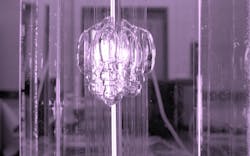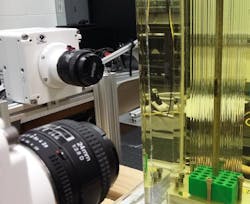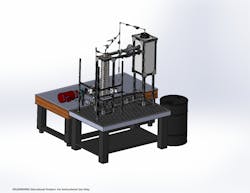To prevent nuclear accidents, sometimes you have to simulate them. That’s exactly what researchers at Oregon State University’s School of Nuclear Science and Engineering are doing as they seek to drive the development of nuclear science through engineering and health physics.
Professor Wade Marcum and PhD Student Griffen Latimer from the Oregon State University’s School of Nuclear Science and Engineering are leading the project to simulate nuclear explosions. Latimer is executing this work that specializes in nuclear energy-based research. The goal is to learn how to make current nuclear reactors safer and more economic, in addition to developing new plant concepts. To accomplish these goals, Marcum and Latimer simulate nuclear accidents—an experimental process that involves two things: seeing inside a nuclear reactor and slowing down fuel assembly failure using two high-speed Phantom cameras.
A Lab of What-Ifs
Oregon State University simulate nuclear accidents using a pressurized water reactor (PWR). PWRs make up most of the world’s nuclear power plants. In this kind of system, water is pumped under high pressure to the reactor core, where it is heated by the energy released by nuclear fission.
“Our goal is to ‘see’ what’s going on inside a nuclear reactor when it’s operating—which is impossible,” Marcum said. “Reactors operate at very high pressures and fluid temperatures. The conditions are extremely hazardous.”
Since going inside a reactor was out of the question, Marcum and his team constructed a mock reactor, which operates at much lower pressures in a laboratory setting. The setup allows the researchers to visualize some of the conditions that a real nuclear reactor experiences during operation. It also allows them to simulate and observe what happens if something goes wrong.
“The conditions we’re interested in are off-normal, meaning they’re accident scenarios,” Marcum said. “Essentially, we’re trying to answer the what-if questions: What if the plant malfunctions? More specifically, what if a fuel element breaks?”
That’s where the mock reactor comes in—a small, benchtop-scale loop with water flowing through it, simulating a Pressurized Water Reactor (PWR). PWRs make up most of the world’s nuclear power plants. In this kind of system, water is pumped under high pressure to the reactor core, where it is heated by the energy released by nuclear fission. The heated water then flows to a steam generator, where it transfers its thermal energy to a secondary steam-generating system. The pressurized steam is then fed through a steam turbine, which drives an electrical generator.
A typical PWR fuel assembly weighs about half a ton and stands between 4 and 5 meters high. Fuel rods within the reactor core house the uranium dioxide, which provides the nuclear fuel. These rods are grouped together into fuel assemblies, or bundles. The outer layer of the fuel rods, known as the cladding, allows the water to be heated while also preventing radioactive fission fragments from escaping the fuel and contaminating the water.
To capture the mock nuclear reaction, the research team uses high speed cameras to capture the explosion.
As part of the model, the research team constructed a small section of a typical PWR fuel assembly, housed in a quartz cylinder. Its central rod consists of a stainless-steel tube with an outside diameter of 0.375 in. The 24 outer fuel rods, comprising the 12-in.-long fuel-bundle section, are made of acrylic and have the same diameter as the central rod. And finally, the central rod is connected to a regulator on a nitrogen tank via a pressure line, allowing the researchers to quickly pump nitrogen in at high pressures.
“Between the acrylic and the quartz, we wanted to build a fuel element using transparent materials, which would let us see into the structure,” Marcum explained. “That way, during our experiments, we can simulate the fuel element breaking and then observe what happens to the fuel.”
Advance Cameras for Fast Recording
The team uses two high-speed Phantom VEO 340L cameras. The 4-megapixel cameras have in excess of 3 gigapixels/second throughputs, translating to recording speeds up to 800 frames per second (fps) at 2560 × 1600 resolution, or more than 1,400 fps at 1080p HD.
Being able to see inside the fuel assembly was just one piece of the puzzle, however. The team also had to figure out a way to slow their simulations down. “Fuel assembly breaks occur in hundreds of microseconds,” he noted. “So, we need to record around 10 times that duration—somewhere on the order of 10 microseconds.” To accomplish that, the researchers utilize two high-speed Phantom VEO 340L cameras. The 4-megapixel cameras have in excess of 3 gigapixels/second throughputs with recording speeds of more than 1,400 frames per second at 1080p HD.
“We break the cladding, then use the cameras under high-speed conditions to understand what happens to the fuel element,” Marcum said. “Does the fuel move all over the place? Does it bend and bow?”
Promising Preliminary Tests
Because there are many ways a fuel assembly can malfunction, Marcum and his team are concerned with simulating only the likeliest scenarios. In a loss-of coolant (LOCA) accident, for example, a PWR’s emergency core cooling system (ECCS) floods the reactor cavity, causing the cladding internal pressure to rise. This can burst the fuel element and eject a plume of fragmented oxide fuel into the coolant, causing multiple safety concerns such as flow channel blockage or localized steam explosions.
The model above is the experimental setup laid out in SolidWorks.
During preliminary LOCA tests, the researchers arranged the cameras in a perpendicular configuration, focusing them on the centerline of the fuel bundle to capture the cladding rupture at different angles. Their aim was to analyze the growth of the plume in the first moments of the breach to characterize its growth and behavior.
To initiate the break, the researchers pressurized the charging line to 400 psig. They then opened the vent valve at the same instant the cameras were triggered, capturing the burst at 800 fps. Afterwards, they analyzed the growth and progression of the plume at six different points (each one 5 ms apart). “So far, the results of our tests are very promising,” Marcum said. “But this is just the beginning of a longer three-year project. Now it’s about collecting all the data.





